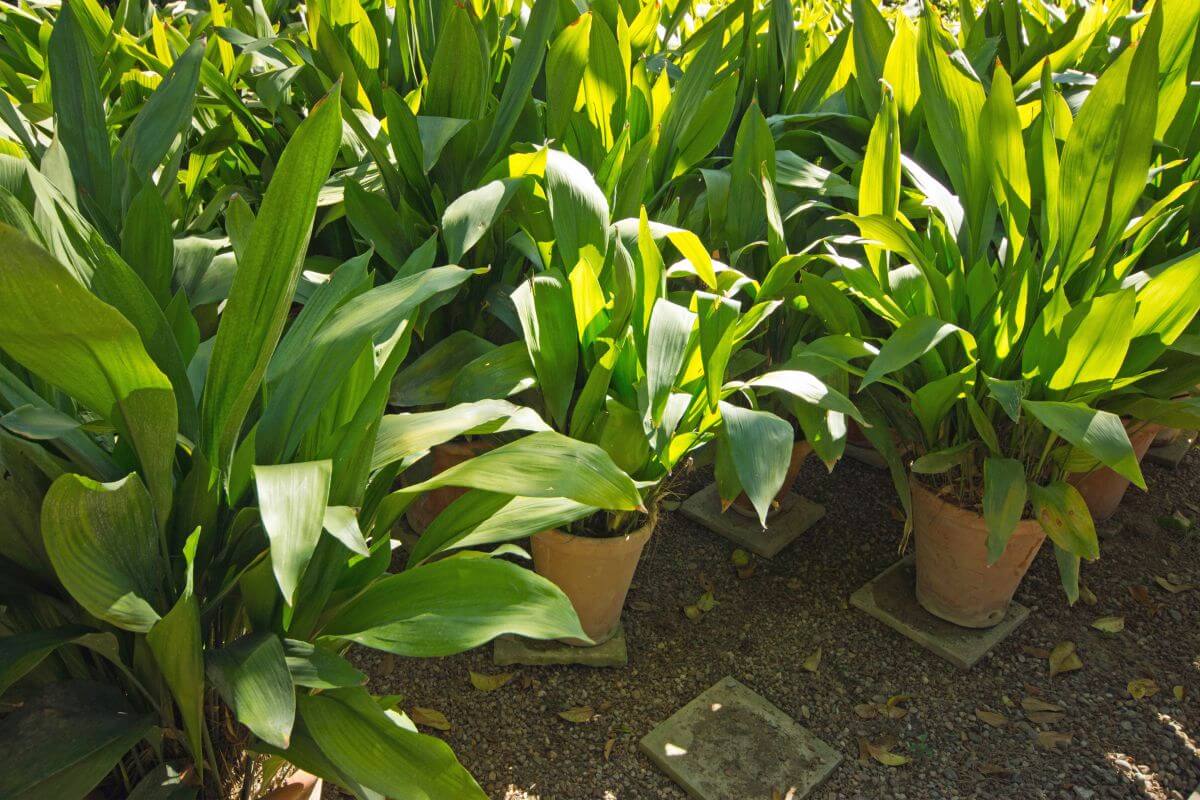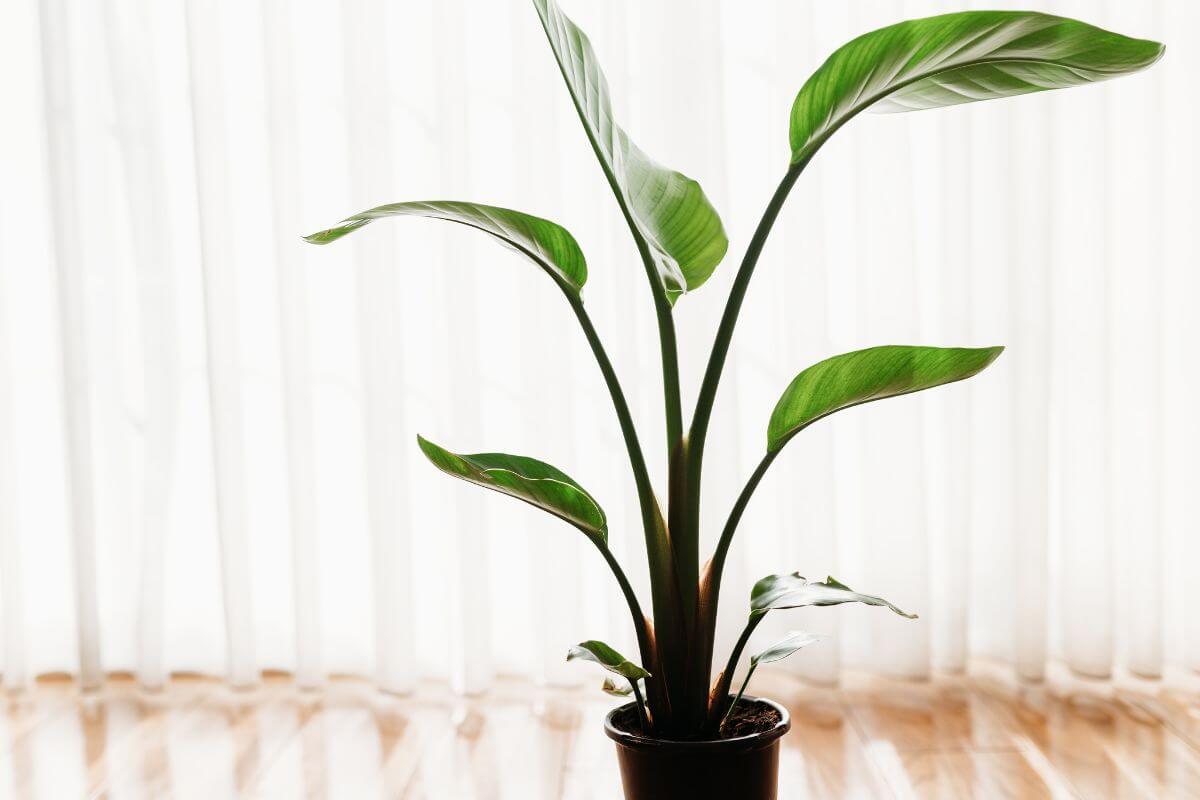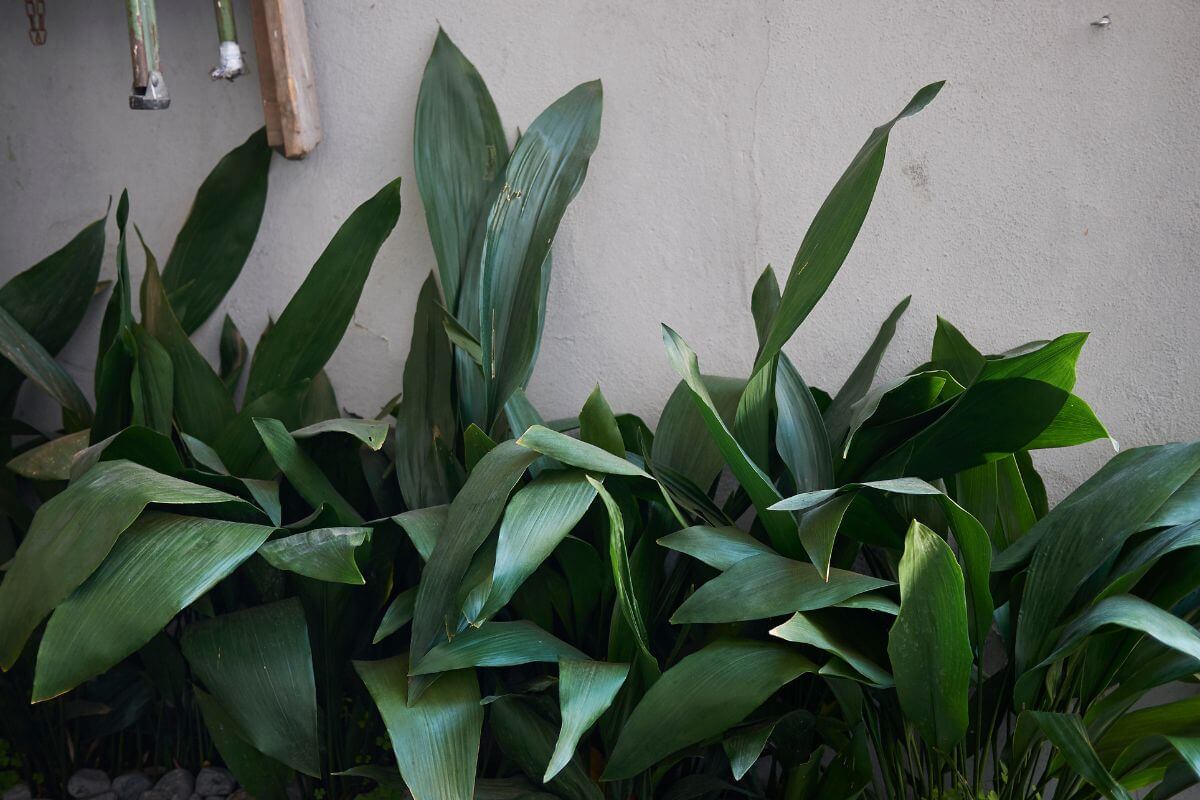If you are searching for a nearly indestructible houseplant, the Cast Iron plant, botanically named Aspidistra elatior, is for you.
The cast iron plant is a hardy houseplant that can survive neglect, forgetfulness, and environmental conditions that would lead to the demise of many houseplants.
Even though it’s a hardy plant, it’s still important to learn how to care for the cast iron plant for healthy growth.
All About the Cast Iron Plant
The Cast Iron plant is native to Asia and a member of the Liliaceae or Lily family. It is also popularly known as the “Bar Room Plant” (barroom plant) or “Ballroom plant”.
This herbaceous perennial’s impressive foliage consists of deep forest green glossy leaves that are shaped like lances on long arching stems.
The cast-iron plant is a slow-growing plant and best to plant in the spring. The leaves can grow to two feet in length and four inches in width.
Besides being a great indoor plant, it’s also successful when cultivated outdoors in the correct growing zones. It will flower purple blooms at the plant’s base.
The Aspidistra elatior features several varieties:
- “Asahi” translated means “Morning Sun” and it features green leaves that develop white tips during growth. This cultivar can develop leaves that arrive to be thirty inches in length and five inches in width. If the pot is too small, the white tips will not develop.
- “Hoshi-Zora” which translates into “starry sky” because the foliage offers a green background with white and yellow dots. It’s even been referred to as the “Milky Way” with the leaves reaching a width of six inches.
- “Lennon’s Song” features leaves with yellow or light green stripes. While many may think it is named for the singer John Lennon, it is actually named for the man whose field produced this variation in Florida.
- “Okame” features white-streaked foliage. Named for a character in Japanese Kyogen Theatre, the foliage appears quite dramatic.
- “Variegated” offers beautiful green foliage striped with white.
Cast Iron Plant Care

If you are a beginner gardener and don’t a green thumb yet, the Cast Iron plant may be just be the starter plant you need for encouragement. This plant is a survivor and can thrive where other plants fail to do so.
Heavy shade or low light conditions do not deter the cast iron plant, and it is fairly resistant to both disease and pest infestations.
These are generous plants that require very little from their owners. Watering when the soil bed dries and some feeding for a part of the year is basically what’s needed.
The two things to avoid will be overwatering as they do not do well in soggy soil and direct sunlight. Left to their own devices, these plants will reward you with attractive foliage.
Soil for the Cast Iron Plant
This is a tolerant plant and as such, it can do well in various soil types providing that they are well-draining soil beds. The ideal soil bed will be organically rich with a slightly acidic pH level that falls in the 4.5 to 7.0 range.
Outdoors, these plants can be cultivated in loamy, sandy soils, but also in clay soils. If you have muddy or clay soil in your garden, you can blend in composted manure or peat moss outdoors to absorb some of the water. Clay soil should be broken up when blending.
To help with maintaining outdoor moisture, mulch can be used. Mulch will also help prevent weeds from invading.
When grown indoors, cast iron plants are fine in a standard potting mix with a container that has adequate drainage holes. It’s important to get a pot with drainage holes to allow excess water to drain.
Light for the Cast Iron Plant
Cast iron plants like Position it near a north-facing window, but not directly in the window to prevent direct sunlight.
The cast iron plant should be kept away from exposure to direct sunlight because it can scorch or burn its leaves.
If you decide to cultivate these plants outdoors, they should be planted in an area that offers partial shade with bright, indirect sunlight.
Water and Humidity for the Cast Iron Plant
The cast iron plant is tolerance to drought, but still prefers a soil bed with moderate moisture. Younger plants should be watered regularly to maintain soil moisture, but be careful to avoid soggy soil.
These plants, like most houseplants, cannot be left to stand in a soggy or water-logged soil bed, as this will lead to root rot. For mature plants, you can water thoroughly.
Let the soil bed dry out at least two inches deep before watering anew. Stick your finger in the soil bed, if you cannot feel any dampness or moisture, you’ll know it’s time to water.
The cast iron plant thrives in moderate humidity, which is typical of normal home humidity.
Temperature for the Cast Iron Plant

The ideal temperature for your cast iron plant should fall in the 60° to 75° Fahrenheit range.
They do not like cold. If temperatures fall below 50° F, they may sustain damage or even die.
If your cast iron plant is in a pot that’s placed on a porch, veranda, or deck, remember to bring it indoors before frost arrives in your area.
Fertilization for the Cast Iron Plant
Cast iron plants should be fertilized monthly during the spring and summer growing season with a basic liquid fertilizer for houseplants.
You can also opt for a slow-release fertilizer to apply in the spring. During autumn and winter, they do not require feeding.
Fertilizer should be diluted and given only after you have watered your plant, so that the plant’s roots are not burned in the process.
Pruning and Repotting the Cast Iron Plant
Pruning a cast iron plant is done for aesthetic purposes and to remove pests. Dead leaves may be hidden by new growth, so you can remove them if so desired. Foliage with insect damage can be trimmed.
Always use sterilized scissors or gardening shears when pruning, so you don’t introduce any infection or diseases.
When you are growing your cast iron, the most important thing to remember is to select a pot with good drainage holes. The container should be a little larger than the plant’s root ball.
As a slow-growing plant, it will not outgrow its container that quickly. When you eventually notice a bit of root peeking out of the soil bed, you will know that it is time to repot.
This may not happen for a number of years, even as many as five. A good rule of thumb is to repot every two to three years.
Repotting should be done in the spring. Remove the plant from its original container gently and place it in a new pot with fresh soil.
Propagating the Cast Iron Plant
Cast iron plants are propagated by division. To cultivate a new plant, remove a piece of your plant’s underground stem, known as a rhizome, that has at least two leaves growing on it.
Place the stem piece in a new container with potting mix, or in your garden soil bed outdoors. The new soil bed should be kept slightly moist to encourage rooting, but should be well-draining.
The new plant should not be in direct sunlight, but should be warm.
When you notice new shoots emerging, you’ll know that your new plant has developed its roots and can be treated as a settled plant.
Cast Iron Plant Toxicity and Pets
According to the American Society for the Prevention of Cruelty to Animals (ASPCA), the cast iron plant is non-toxic to dogs, cats, and horses. That makes it an ideal houseplant for homes with pets.
Cast Iron Plant Pests, Diseases, Problems, and More

Cast iron plants are not very vulnerable to pests as they generallyi avoid the cast iron. Still, a few typical insects that disturb houseplants, in general, can bother your plant.
Spider Mites, scale insects, and mealybugs may visit and should be eliminated quickly. Insecticidal soap or neem oil will do the trick.
The cast iron plant is a bit susceptible to leaf spot diseases, as well as root rot due to overwatering. These diseases are caused by Fusarium, a fungal infection. This infection can destroy rhizome roots.
On foliage, this infection can create spots that are water-soaked and that will become reddish-brown in color eventually. These spots produce spores that will reproduce and can spread.
Leaf blight is a problem when it appears. An organic fungicide should be applied. Leaves with spotting should be pruned, and you should attempt to keep leaves dry.
Another potential infection is Sclerotia rolfii also known as Southern blight. This will appear in the form of brown lesions on the plant’s stems. If it is allowed to progress, the foliage will turn yellow and wilt.
You could find the formation of white mycelium on your plant as well. This fungal infection will spread in soggy soil. Avoid overwatering and apply a copper-based fungicide.
The development of brown leaf tips is usually a watering issue. Overwatering will cause the plant to release water from its tips that in turn become brown. Also, underwatering can provoke brown leaf tips as well. Soil should be kept evenly moist.
Growing Cast Iron Plant Final Thoughts
It’s no wonder that this plant is called the Cast Iron Plant because, like cast iron, it is nearly an indestructible houseplant.
With a little tender loving care, it will be a beautiful addition to any home or office. It also makes a great gift for beginner gardeners, or friends and family members that don’t have much luck with houseplants.
For more houseplant care guides, check these out:
- Bird’s Nest Fern Care Guide
- Boston Fern Care Guide
- Coffee Plant Care Guide
- Bromeliad Plant Care Guide
Growing Cast Iron Plant FAQs
Do cast iron plants need sun?
Yes! Cast iron plants love bright indirect light. Don’t let it sit in direct sunlight for too long or the leaves can burn.
How fast does a cast iron plant grow?
The cast iron plant is a slow grower, taking six months or more to reach maturity depending on when you start growing it and the pot size. The leaves can grow quite large, up to two feet long and four inches wide.
Why are cast iron plants so expensive?
The price of the cast iron plant reflects how long it takes for them to grow. They need to grow for months and years before they’ll grow to a size that’s salable. But when they do sell, they’ll continue growing and surviving with little maintenance.
Are cast iron plants toxic to humans?
Cast iron plants are not toxic to humans or pets. They make for great houseplants if you have a big family with kids and pets, because they are also hardy plants.
Do cast iron plants like to be misted?
No, you shouldn’t mist the cast iron plant as wet leaves can lead to leaf blight. But you should be regularly watering the soil, because they like moist soil beds.
Does the cast iron plant purify air?
Yes, cast iron plants are one of the best air purifying plants. They’re good at absorbing toxins in the air.


